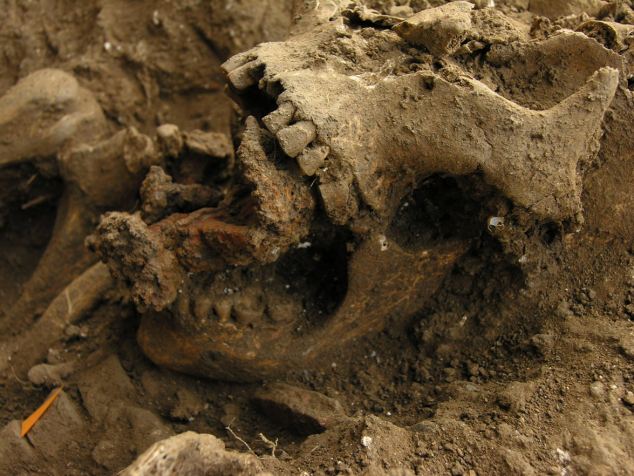
|
|||
800-year-old remains of witch discovered in Italian graveyard … with seven nails driven through her jaw
Source: http://www.dailymail.co.uk/news/article-2041671/800-year-old-remains-witch-discovered-graveyard-Tuscany-Italy.html#ixzz1b8wsn0EL

These are the 800 year old remains of what archaeologists believe was a witch from the Middle Ages after seven nails were found driven through her jaw bone.
The grim discovery was made during a dig on what is thought to be a 'witches graveyard' after another woman's skeleton was found surrounded by 17 dice - a game which women were forbidden from playing 800 years ago.
Experts say they believe the women are aged around 25 - 30 years old and were found buried in a simple shallow grave in the ground with no coffin or shroud.
The macabre remains were found during a dig close to the sea at Piombino near Lucca in Italy's Tuscany region and the woman had seven nails through her jaw as well as another 13 nails surrounding her skeleton.
Archaeologist Alfonso Forgione, from L'Aquila University, who is leading the dig, is convinced that the women were suspected witches because of the circumstances in which they were buried.
He said: 'It's a very unusual discovery and at the same time fascinating. I have never seen anything like this before. I'm convinced because of the nails found in the jaw and around the skeleton the woman was a witch.

Read more: http://www.dailymail.co.uk/news/article-2041671/800-year-old-remains-witch-discovered-graveyard-Tuscany-Italy.html#ixzz1b8xk2Iee
'She was buried in bare earth, not in a coffin and she had no shroud around her either, intriguingly other nails were hammered around her to pin down her clothes.
'This indicates to me that it was an attempt to make sure the woman even though she was dead did not rise from the dead and unnerve the locals who were no doubt convinced she was a witch with evil powers.
'The second skeleton we have found was buried in a similar fashion but this time we found 17 dice around her - 17 is an unlucky number in Italy and also dice was a game that women were forbidden to play.
'The way the bodies were buried would seem to indicate some form of exorcist ritual and the remains will be examined to see if we can establish a cause of death for them.'
One puzzle that the archaeologists have been unable to explain is why the women if they were evil witches were buried in consecrated ground as the area is the site of an 800 year old church.
He said: 'The only possible explanation is that perhaps both women came from influential families and were not peasant class and so because of their class and connections were able to secure burial in consecrated Christian ground.'

The team is trying to find the burial place of the St Cerbonius, a bishop who died more than 1,500 years ago and who is the local patron saint of the area.
Read more: http://www.dailymail.co.uk/news/article-2041671/800-year-old-remains-witch-discovered-graveyard-Tuscany-Italy.html#ixzz1b8xk2Iee
![]()
Submit News/Videos/Links |
Discuss article |
Article Link
|
More unsolved mysteries on Unexplained Mysteries
More can be addded on request. Direct your requests at vinit@theunexplainedmysteries.com